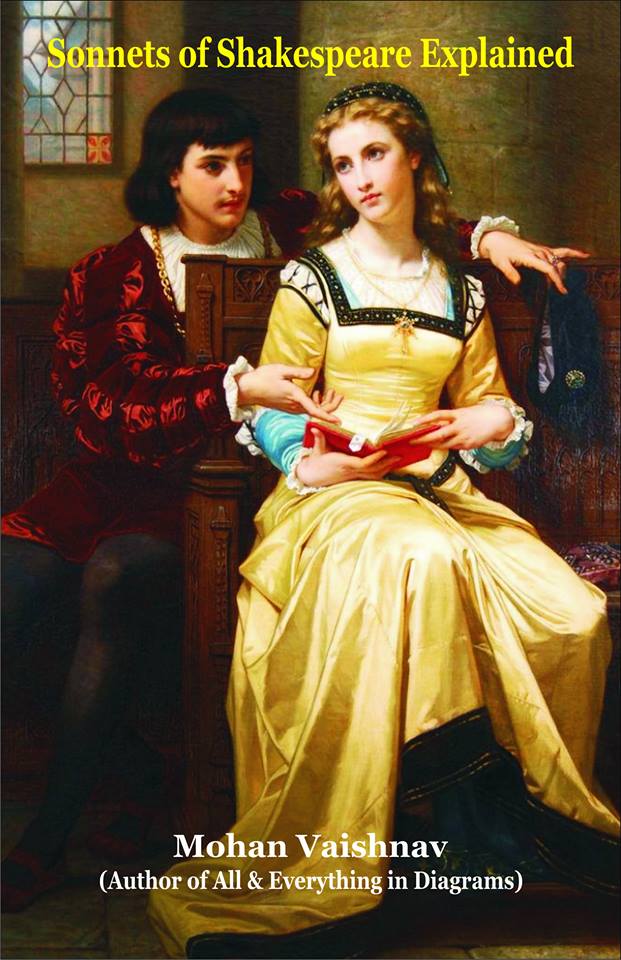“Sonnets of Shakespeare Explained” is the second book from the prolific pen of Mr. Mohan Vaishnav, the author of “All and Everything in Diagrams”. His first book was acclaimed by the lovers of esoteric traditions, spiritual traditions and specially Fourth Way tradition. Mr. Mohan Vaishnav is basically a corporate law professional based at Ahmedabad. He is partial to literature, fine arts and applied philosophy. He  believes that the literature having high seriousness and sublimity has great transforming force that can transfigure one’s soul. As the authors himself said, “ the book “Sonnets of Shakespeare Explained” intends to briefly explain the meaning of each sonnet, so that the reading of original Sonnets become more enjoyable, even for a reader who may not be much familiar with Shakesperian style of writing.”
believes that the literature having high seriousness and sublimity has great transforming force that can transfigure one’s soul. As the authors himself said, “ the book “Sonnets of Shakespeare Explained” intends to briefly explain the meaning of each sonnet, so that the reading of original Sonnets become more enjoyable, even for a reader who may not be much familiar with Shakesperian style of writing.”
The Sonnets of Shakespeare are considered as masterpiece of world literature. Mostly all the universities of the world where English language and literature is taught, Shakespeare’s sonnets are prescribed in syllabus. The sonnets are pregnant with higher meanings and philosophy of life. Shakespeare has dealt with various subjects and aspects of life such as love, truth, eternity, time etc. in these sonnets. Shakespeare has unfolded the treasure of truths and understandings of life in these sonnets. Not only they enhance our understanding and impart great aesthetic pleasure but also create greater awakening in the readers too. They are written in Shakespearean English. English language used during the Age of Chaucer and the Age of Shakespeare Age is significantly different from the English used in our times.
The book serves the purpose of making one’s reading of these sonnets quite understandable, simple and meaningful without marring the pleasure of reading the original sonnets. One of the interesting things about this book is that the author has maintained a sequence of giving the explanation side by side, the sonnet on the left page and its explanation on the right page. Without turning the page, the sonnets and explanation can be read side by side. Hence, the reading becomes easy going. The author has intentionally given the explanation briefly. The explanation does not exceed one page. It maintains the size and sequence of a sonnet. Reading the original sonnet on the left page and its explanation on the right page, this side by side reading, makes the process of enjoyment very aesthetic. Unlike other editions wherein the explanations are given in full critical detail or the editions wherein footnotes are provided to ease the matter of the students, Mr. Mohan Vaishnav has taken up a novel approach. He appears to be a trend setter here. He does not come between a reader and Shakespeare. The explanations, along with the words and meanings put into brackets at several places if need be, do not interfere with readers’ intent on having aesthetic pleasure. The author has intentionally provided the explanation in such a way that the imminent problem of obstacles and obscurities that can mar the beauty of aesthetic pleasure can be eradicated. With the text on the left page and the explanation on the right one make the reading more meaningful and enlightening. The explanation does not thrust any views and interpretations on the readers. On the contrary, it plays a role of helping the readers evoke their own original responses and spontaneous interpretations.
For example, Sonnet No. 51 page no. 112 and its explanation on page no. 113. In the first four lines, Shakespeare says
“Thus can my love excuse the slow offence
Of my dull bearer, when from thee I speed:
From where thou art why should I haste me thence?
Till I return, of posting is no need.”
The explanation is as under:
O my love, thus can you please excuse the slow offence (offence
of going slow) of my dull horse (bearer) when from you I depart:
why should I make haste in departing from the place where you
are? There is no need of speeding, till I return back towards you.
We can clearly see here that the explanation remains explanation, it does not interfere with the process of enjoying the original text, and serves the purpose of enjoying the text more aesthetically with sustaining comprehensibility. Offence is here the offence of going slow, the bearer here means the horse. Why should I haste me thence?? meaning here, thereby there is no need of speeding, till I return back towards you….Now an ordinary reader can assimilate the implied meaning that there is no need to make haste as the speaker is going back after meeting the beloved. The speaker must make haste if he is on the path of meeting the beloved.
The book contains all the 154 sonnets of Shakespeare and their explanations. Shakespeare’s literature adds great beauty to any library. This book shall also be one more feather in the cap. It will not only enhance the number of the readers of Shakespeare’s sonnets but also justify the popularity of Shakespeare as a great sonneteer. For the lovers of literature as well as the students of English literature, this book proves to be a great boon. The cover photo of the book is a painting of Romeo & Juliet by French Painter Hugues Merle (1823-1881) – Painted in 1879. It is so appealing that we cannot resist the temptation of treasuring the book forever.
Book Details:-
| Author: | Mohan Vaishnav | ||
| Publisher: | Shambhabi – The Third Eye Imprint | Publication Year: | 2014 |
| ISBN-13: | 9781500669805 | ISBN-10: | 1500669806 |
| No. Of Pages: | 320 | Cover: | Paperback |
| MRP |
325 Rs | Buy From: | Infibeam.com Flipkart.com |
Final Words
My Rating
5
Must for the Lovers and Students of Literature
Book Reviewed By Dr. Mihir M. Dave, Dept. of English Language and Literature, G.D.Modi College of Arts, Palanpur.
Tags: Mohan Vaishnav Sonnets of Shakespeare Sonnets of Shakespeare Explained Sonnets of Shakespeare Explained review








